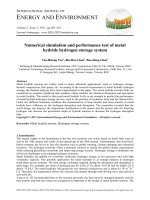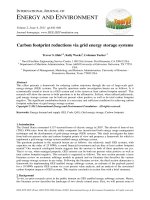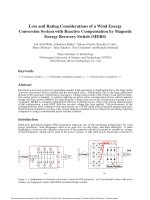Thermic fluid based solar thermal energy storage system for milk processing
Bạn đang xem bản rút gọn của tài liệu. Xem và tải ngay bản đầy đủ của tài liệu tại đây (449.55 KB, 12 trang )
Int.J.Curr.Microbiol.App.Sci (2019) 8(10): 1962-1973
International Journal of Current Microbiology and Applied Sciences
ISSN: 2319-7706 Volume 8 Number 10 (2019)
Journal homepage:
Original Research Article
/>
Thermic Fluid Based Solar Thermal Energy Storage System
for Milk Processing
Mukul Sain*, Amandeep Sharma, Gopika Talwar and Nitika Goel
Department of Dairy Engineering, College of Dairy Science and technology,
GADVASU, Ludhiana, 141004, India
*Corresponding author
ABSTRACT
Keywords
Thermal reservoir,
Thermic fluid,
Solar energy, Milk
Article Info
Accepted:
15 September 2019
Available Online:
10 October 2019
The main objective of this research was to develop a solar energy based thermal reservoir
cum heat exchanger using thermic fluid viz. paraffin oil as thermal heat storage and heat
transfer medium for generation of hot water which can be used for milk processing
operation like pasteurization of milk. In this research, basically three mild steel pressure
vessels were constructed; one of which was simply a concentric mild steel vessel with a
single cavity (configuration 1) which was only used for the preliminary study of thermic
fluid and based on this, a thermal reservoir with two different configurations
(configuration 2 and configuration 3) were constructed for hot water generation which
could be continuously circulated for in plant processing of milk. In thermal reservoir, there
were three layers viz. section 1, section 2 and section 3. Among these layers, section 1 was
cavity for thermic fluid, section 2 for steam generation and section 3 was for production of
hot water for circulation. In configuration 2, there was a copper pipe (section 3) for hot
water circulation but due to some cons, another configuration viz. configuration 3 was
developed by replacing section 3 of configuration 2 with a drum of high volume and thus a
complete setup was developed for generation of hot water to be circulated for continuous
processing of milk even after peak sun hours. Earlier a research study was performed in
college of Dairy Science and technology, GADVASU by M.tech (Dairy Engineering)
student for solar in-bottle sterilization of milk; it was found that solar energy could be
effectively used up to 3 P.M. This study was in continuation with that study and thus a
thermal reservoir was designed and fabricated to trap the sun’s heat energy in peak hours,
which could be effectively utilized in off sun hours i.e. after 3 P.M.
Introduction
India is world’s largest milk producer with an
annual production of 176.4 MT (NDDB 201819). Also, most of the milk in India is handled
by unorganized sector and most of the dairy
farmers are small milk holders. Milk is a
perishable commodity and needs immediate
processing to prevent the growth of
microorganisms. Milk processing mainly
involves heating and cooling operations and it
is found that for most of the milk processing
operations, temperature up to 90oC is required
(Jaglan et al., 2018). On the other hand,
mainly conventional or non renewable energy
sources are used for milk processing but as we
1962
Int.J.Curr.Microbiol.App.Sci (2019) 8(10): 1962-1973
know that our country has major energy crisis
as well as conventional energy sources causes
a lot of environmental pollution. It’s a must
thing to shift from non-renewable to
renewable energy sources if we want the
future generation to live in a pollution free
environment. India has a great potential to
shift from non-renewable to renewable
sources like wind energy, geothermal energy,
biomass, solar energy, tidal energy etc.
Among them, solar energy has a great scope in
a country like India where sun shines in
abundance. India gets around 5-7 KWh/m2 of
solar energy for about 300-320 days in a year
due to which it can be utilized as a great
source of energy for electricity production,
transportation, cooking food, heating water
and sterilizing of milk (Desai et al., 2013;
Sharma et al., 2012). The only problems
encountered in use of solar energy are
inconsistent sunrays and off peak hours. Also
the type of equipments reported for solar milk
processing has a drawback that these have to
be mounted on the focal point of the parabolic
concentrators (Franco et al., 2008). Reliability
of solar energy can be increased by storing its
portion when it is in excess of the load and
using the stored energy whenever needed.
Solar energy cannot be stored as such, so first
of all energy conversion has to be brought
about and then depending on this conversion,
a storage device is needed.
Thermal energy can be stored in sensible as
well as latent heat. Of the available sensible
heat storage materials, thermic oils like
paraffin oil, silicon oil etc. can be the best
choice in storing high degrees of temperature
(Singh et al., 2018). Paraffin oil (thermic
fluid) is one of the useful thermic fluid, which
can be used for high temperature applications
without any vapor formation. Paraffin oil can
act as heat storage as well as heat exchange
medium in heat exchangers in solar thermal
energy storage systems (Sain et al., 2019).
Materials and Methods
A solar energy based thermal reservoir was
developed and
fabricated with two
configurations. The material used for pressure
vessels need to be strong enough to withstand
high pressure for reliable and safe operation.
Therefore, it was important to make the right
choices in selecting the perfect material for
pressure vessels. Mild steel or low carbon
steel is widely used for such operations, as
mild steel is capable of retaining strength even
at minimal thickness. It also resists vibrations,
shocks and has excellent tensile strength and
recycles properties. So, mild steel was used as
material for thermal reservoir. The cavity was
constructed with the help of lathe machine as
shown in Figure 1, to make it a single piece
and seamless as pressure was supposed to be
generated. The unit was made up of mild steel
(AISI 1018) and the dimension of the unit was
worked out using the following equation.
Thickness of sheet t = P * R/ (2SE – 0.6P)
Where,
t = Cylinder thickness in corroded condition
P = Design pressure
R = Cylinder Inside radius in corroded
condition
S = Maximum Allowable Stress at design
temperature
E= Joint Efficiency
Circumferential Stress S1=
Longitudinal Stress S2=
Where,
P= internal pressure
D= mean diameter
t= thickness of sheet
The value of various parameters required
calculating
the
thickness
of
sheet,
1963
Int.J.Curr.Microbiol.App.Sci (2019) 8(10): 1962-1973
circumferential Stress and longitudinal Stress
was taken as below:
For calculate the thickness of sheet the design
temperature was consider to be maximum of
180oC and corresponding steam pressure from
standard steam table was
1096383.5 Pa. Therefore Design pressure (P)
was taken as 1100000 Pa (considering factor
of safety)
4 and safety valve starts functioning when
pressure exceeds from 4kg/cm2. At the inlet
and outlet of the section 3, separate
temperature gauges were used ranging from 0
to 200oC.A centrifugal pump (make: Kenasa)
was used for hot water circulation as shown in
Figure 5. The pump used was of 1 HP and its
rating speed was 2800 rpm. The pump size
was 25×25 mm. The flow rate of pump was 20
liter/minute as recorded during the study.
Configuration 1
Maximum Allowable Stress at design
temperature (S) = 138000000 Pa (Chandler
1994)
Joint Efficiency (E) = 1.82 (Chandler 1994)
The fabrication of thermal reservoir was a
double-jacketed insulated cylinder with three
sections that is 0.33 m in length. The inner
cylinder was 0.28 m and outer radius was 0.42
m. It was made of mild steel. There were 3
sections viz. section 1 (For thermic oil),
section 2 (For steam generation), section 3
(Hot water generation for circulation). The
section 2 was well insulated with glass wool to
a thickness of 7 cm. The section 1 was fitted
with section 2 with the help of arc welding.
The size of the cavity of section 1 was decided
according to the expansion of thermic fluid.
The volume of section 1 cavity was kept larger
than the quantity of thermic fluid required for
thermal heat storage as paraffin oil and other
thermic fluids expand on heating (Sain et al.,
2019).
Temperature gauge was used at each section
to indicate the increase in temperatures in
working oils. At oil side, a bimetallic
temperature gauge of resolution 2oC was used
ranging from 0 to 200oC as shown in Figure 2.
At the top of the lid, a temperature gauge
having range from 0 to 500oC was used as
shown in Figure 3. Pressure gauge was having
range from 0 to 10kg/cm2 as shown in Figure
The configuration 1 was a concentric mild
steel vessel, which was enclosed with an
airtight circular lid. The lid was mounted with
a temperature gauge, pressure gauge and a
safety valve. Temperature gauge was having
range from 0to 250oC, pressure gauge was
ranging from 0 to 20 kg/cm2 and safety valve
started functioning when pressure started
exceeding from 4kg/cm2.The sterilizing unit
was made up of mild steel (AISI 1018) and
was painted black to increase the heat
absorption. The configuration 1 was used to
check the solar thermal profile of thermic fluid
and according to which a thermal energy
storage system (thermal reservoir cum heat
exchanger) was developed. The schematic
diagram of configuration 1 can be seen in
Figure 6.
Configuration 2
In configuration 2,a copper pipe was fitted in
section 2 (refer to Fig. 12) with the help of gas
welding. Copper tubes are extensively used to
offer
the
highest
performance
for
enhancement of heat transfer rate. Copper has
high thermal conductivity, which enhances the
heat in terms of precision. The copper tube
used was spirally bended to increase the
contact area. A copper pipe of 3.05m length
and 12 mm diameter was fitted inside the
steam section. The copper pipe was joined
with the help of gas welding as gas welding
1964
Int.J.Curr.Microbiol.App.Sci (2019) 8(10): 1962-1973
provides maximum strength. Figure 7 shows
the arrangement of copper pipe (Table 1).
Results and Discussion
Development and fabrication of solar
thermal reservoir
Configuration 3
The thermal reservoir was further modified
and fabricated to make it more efficient. The
copper pipe was detached and a cylindrical
drum of mild steel was inserted in place of
copper pipe and was fixed with the help of gas
welding. The drum was of 9.5 liters capacity
(as shown in Fig. 7). The main advantage of
using the drum was that it can carry a high
volume of water (9.5 liters) and thus hot water
for circulation was available in larger quantity.
Also it took lesser time to achieve the
circulation temperature (90oC).
Fittings
At inlet and outlet of copper pipe, a PVC pipe
was attached with the help of clamp sets as
shown in Figure 9. Clamp sets were used for
tightly fixing the pipe as the water was
circulating with a very high pressure. One end
of the pipe was connected with the pump and
other end was connected with thermal
reservoir and thus hot water circulation was
done with the help of the centrifugal pump as
shown in Figure 14.
Insulation
The insulation was done at both sides of
thermal reservoir’s section 2 with the help of
Glass wool (i.e. glass in the form of fine
fibers). Glass wool was properly filled around
the section 2 with the help of hammer as
shown in Figure 10. This process traps a
number of small pockets of air between the
glass and these small air pockets result in high
thermal insulation properties.
The insulation thickness was 7cm. The
thermal reservoir was also black painted to
increase the heat absorption.
A double-jacketed thermal reservoir (batch
type) was developed. Figure 11 shows the
final picture of the developed thermal
reservoir. Refer to Figure 12 and 13, there
were three sections viz. section 1, bottom
section for heating of thermic fluid, section 2
was cavity just above the section 1, separated
by a metallic boundary; for generation of
steam and section 3 was a copper pipe for
configuration 1 and a mild steel cavity
(cylinder) for configuration 2; for hot water
circulation. The double-jacketed thermal
reservoir was of cylindrical shape and was
made of mild steel. Capacity of doublejacketed vessel at oil side was 6 liters and at
waterside was 18 liters. The copper pipe was
of 3.05 m length and 12 mm diameter. The
cylindrical drum inserted was of 0.22 m
diameter and 0.279 m length. The whole
reservoir was constructed with the help of
lathe machine and arc welding was done to
attach the oil side cavity with waterside cavity.
The heat transfer is complex phenomena
affected by several factors such as amount of
heat energy concentrating, area of heat
transfer, material of heat exchanger, heat
losses and many inter related factors. The
section 2 was well insulated with the help of
glass wool to avoid heat losses by convection.
In tertiary heating section i.e. section 3,
initially there was a copper pipe inserted in the
steam section to circulate the hot water for inplant processing which was then replaced with
a mild steel cylindrical drum as shown in
Figure 13.
The processing unit consisted of a doublejacketed cylinder enclosed with an airtight
circular lid. It was mounted with temperature
gauges, pressure gauge and a safety valve as
1965
Int.J.Curr.Microbiol.App.Sci (2019) 8(10): 1962-1973
shown in Figure 9. The two separate
temperature gauges fitted at inlet and outlet
side of section 3, which gives the inlet and
outlet temperature of circulating water
(temperature gauge 2 and temperature gauge 3
respectively) can be seen in Figure 9. There
was separate inlet and outlet for filling and
drainage of thermic oil as shown in Figure 12
and 13.
Fabrication of configuration 2
Initially configuration 2 was developed and
fabricated
with
the
above-discussed
procedure. Although configuration 2 was also
found successful in achieving the aim which
was to process the milk but as it took a very
long time to achieve the circulation
temperature i.e. 90oC, further modification
was done in section 3 of configuration 2 and
thus configuration 3 was developed and
fabricated. Configuration 2 had following
specifications:
Fabrication of configuration 3
Configuration 3 was quite similar to
configuration 2. Section 1 and section 2 were
exactly same as that of configuration 2. The
only difference in configuration 3 was of
section 3. The lid of configuration 2 was
detached and a cylindrical drum was inserted
in place of copper pipe as it could contain a
very high volume of water, which decreased
the time to achieve circulation temperature as
volume of water and contact area of section 3
with hot water (section 2) was more in
configuration 3. Table 2 shows complete
specifications of configuration 3.
Table.1 Specifications of configuration 2
S. No.
1.
2.
3.
4.
5.
6.
7.
8.
Specification
Diameter
Height
Volume of section 1
Volume of section 2
Volume of section 3
Length of copper pipe
Diameter of copper pipe
Thickness of sheet
Units
0.42 m
0.31 m
6L
18 L
0.34 L
3m
12mm
3 mm
Table.2 Specifications of configuration 3
S. No.
1.
2.
3.
4.
5.
6.
Specification
Diameter
Height
Volume of section 1
Volume of section 2
Volume of section 3
Thickness of sheet
1966
Unit
0.42 m
0.31 m
6L
18 L
9.5 L
3 mm
Int.J.Curr.Microbiol.App.Sci (2019) 8(10): 1962-1973
Fig.1 Construction of cavity
Fig.2 Temperature gauge (0-200oC)
Fig.3 Temperature gauge (0-500oC)
Fig.4 Pressure gauge
Fig.5 Centrifugal Regenerative pump
1967
Int.J.Curr.Microbiol.App.Sci (2019) 8(10): 1962-1973
Fig.6 Configuration 1
Fig.7 Copper pipe for hot water circulation (Configuration 2)
Fig.8 Cylindrical drum (Configuration 3)
1968
Int.J.Curr.Microbiol.App.Sci (2019) 8(10): 1962-1973
Fig.9 PVC pipe fixed with the help of clamp set
Fig.10 Glass wool insulation
Fig.11 Thermal reservoir
1969
Int.J.Curr.Microbiol.App.Sci (2019) 8(10): 1962-1973
Fig.12 Configuration 2 (All dimensions are in meters)
Fig.13 Configuration 3 (All dimensions are in meters)
1970
Int.J.Curr.Microbiol.App.Sci (2019) 8(10): 1962-1973
Fig.14 Milk processing setup
Fig.15 Time taken to reach circulation temperature (section 3)
The complete solar set up for milk processing
(for which the thermal reservoir was
fabricated) can be seen in the following figure
in which the developed thermal reservoir is
placed on the focal point of the parabolic
concentrator and thus hot water generated in
section 3 was used for continuous circulation
for processing of milk. Configuration 3 was
constructed by modifying section 3 of
configuration 2 as configuration 2 was found
1971
Int.J.Curr.Microbiol.App.Sci (2019) 8(10): 1962-1973
less efficient in terms of quantity of hot water
generated for circulation as well as it took
more time for achieving required temperature
of water to be used for circulation. Refer to
Figure 14, the solar thermal reservoir was
placed on the focal point of the solar
concentrator. The configuration 3 took lesser
time as comparative to configuration 2 in
terms of achieving circulation temperature
(90oC) as shown in Figure 15. Although
circulation temperature was achieved in both
the configurations and the aim of the study
which was to extend solar working was also
achieved and the time was extended from 2 to
3 hours.
The parabolic solar concentrator focused all
the scattered sun radiations at the section 1,
which resulted in heating up of thermic oil
present in section 1 of the reservoir. The
section 2 simultaneously took the heat from
thermic fluid (paraffin oil) present in section1
and thus the heat is supplied to section 3.
When the temperature of section 3 exceeded
90oC, circulation was started with the help of
pump and PVC pipes. The milk was placed in
the insulated container to check the heating of
milk with the circulating water as shown in
Figure 14. This method was adopted just for
the primary study of circulated hot water to
heat the milk. After that a suitable tube in
tube type milk pasteurizing equipment was
developed and complete performance
evaluation under different sun and weather
conditions was done but the results are not
discussed in this research paper as this paper
is only related to the fabrication of suitable
thermal reservoir.
Conclusions of the study are as follows
1. The developed thermal reservoir was
able to generate hot water in a
sufficient temperature range which
could easily process the milk even
after off peak sun hours.
2. The thermal reservoir extended the
solar working hours from 2 to 3 hours.
3. The thermic fluid viz. paraffin oil can
be used for thermal energy storage for
almost all the milk processing
operations.
4. The developed thermal reservoir has a
simple design and the technology can
be adopted by small scale dairy
holders.
Future work
This thermal reservoir was developed for
small-scale dairy holders as unorganized
sector and small-scale dairy farmers handle
most of the milk. With slight modification in
the set up, this technology can also be
successfully used at larger scale. A series of
large size solar parabolic collectors can be
used and thermal reservoirs of higher quantity
should be developed to process the milk at
bigger scale.
References
Chandler H. (Ed.). 1994. Heat treater's guide:
practices and procedures for irons and
steels. ASM international.
Desai D D, Raol J B, Patel S and Chauhan I.
2013. Application of Solar energy for
sustainable
Dairy
Development.
European Journal of Sustainable
Development 2(2): 131-140.
Franco J, Saravia L, Javi V, Caso R and
Fernandez C. 2008. Pasteurization of
goat milk using a low cost solar
concentrator. Journal of Solar Energy,
82(11): 1088-94.
Jaglan N, Sharma A, Sain M and Singh L.
2018. Solar technologies and Thermic
materials for value addition to
perishable
commodities:
Future
research & development. Green
Farming 9(3):534-40.
Sain M, Sharma A, Talwar G, Kumar N.
1972
Int.J.Curr.Microbiol.App.Sci (2019) 8(10): 1962-1973
Study on behaviour of thermal energy
storage materials under conventional
and solar heating systems. International
Journal of Chemical Studies, 7(5): 732738.
Sharma N K, Tiwari P K and Sood Y R. 2012.
Solar energy in India: Strategies,
policies, perspectives and future
potential. Renewable and Sustainable
Energy Reviews 16(1): 933-41.
Singh L, Talwar G, Sharma A, Kumar N.
Selection of thermo fluid in double
jacketed vat for Basundi manufacture.
International Journal of Chemical
Studies 6(6):1470-1477.
How to cite this article:
Mukul Sain, Amandeep Sharma, GopikaTalwar and NitikaGoel. 2019. Thermic Fluid Based
Solar Thermal Energy Storage System for Milk Processing. Int.J.Curr.Microbiol.App.Sci.
8(10): 1962-1973. doi: />
1973









